Evaluating PLF for ArchiFarm Dairy: A Case Study on Livestock
VerifiedAdded on 2020/02/24
|18
|3626
|72
Report
AI Summary
This report analyzes the ArchiFarm Dairy Company case study, focusing on the application of Precision Livestock Farming (PLF) in the Australian dairy industry. The essay assesses the suitability of PLF in enhancing productivity, considering stakeholders like distributors, retailers, employees, and customers. It identifies key drivers such as profitability, market presence, and technology. The report examines business functions including production, distribution, sales, and management, and analyzes business processes like administration, production, operations, procurement, and performance management. It highlights the benefits of PLF in optimizing production, mitigating risks, and improving milk quality. The report concludes that PLF is highly suitable for Australian dairy enterprises, recommending its full implementation to address challenges like high labor costs and increasing market demand. The study employs ArchiMate diagrams to illustrate stakeholder relationships, business functions, and processes, providing a comprehensive overview of the company's operations and potential for improvement through PLF technology.
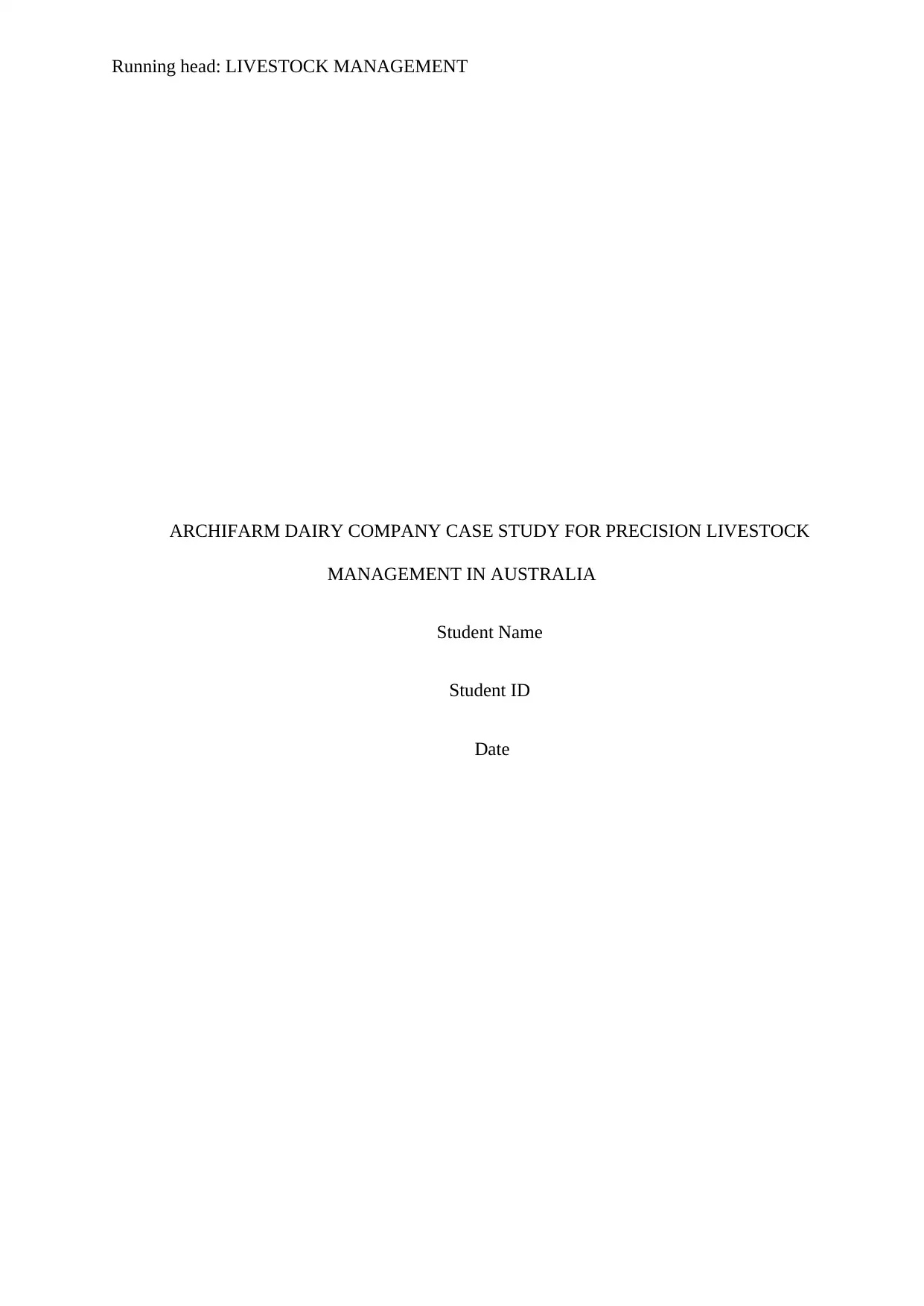
Running head: LIVESTOCK MANAGEMENT
ARCHIFARM DAIRY COMPANY CASE STUDY FOR PRECISION LIVESTOCK
MANAGEMENT IN AUSTRALIA
Student Name
Student ID
Date
ARCHIFARM DAIRY COMPANY CASE STUDY FOR PRECISION LIVESTOCK
MANAGEMENT IN AUSTRALIA
Student Name
Student ID
Date
Paraphrase This Document
Need a fresh take? Get an instant paraphrase of this document with our AI Paraphraser
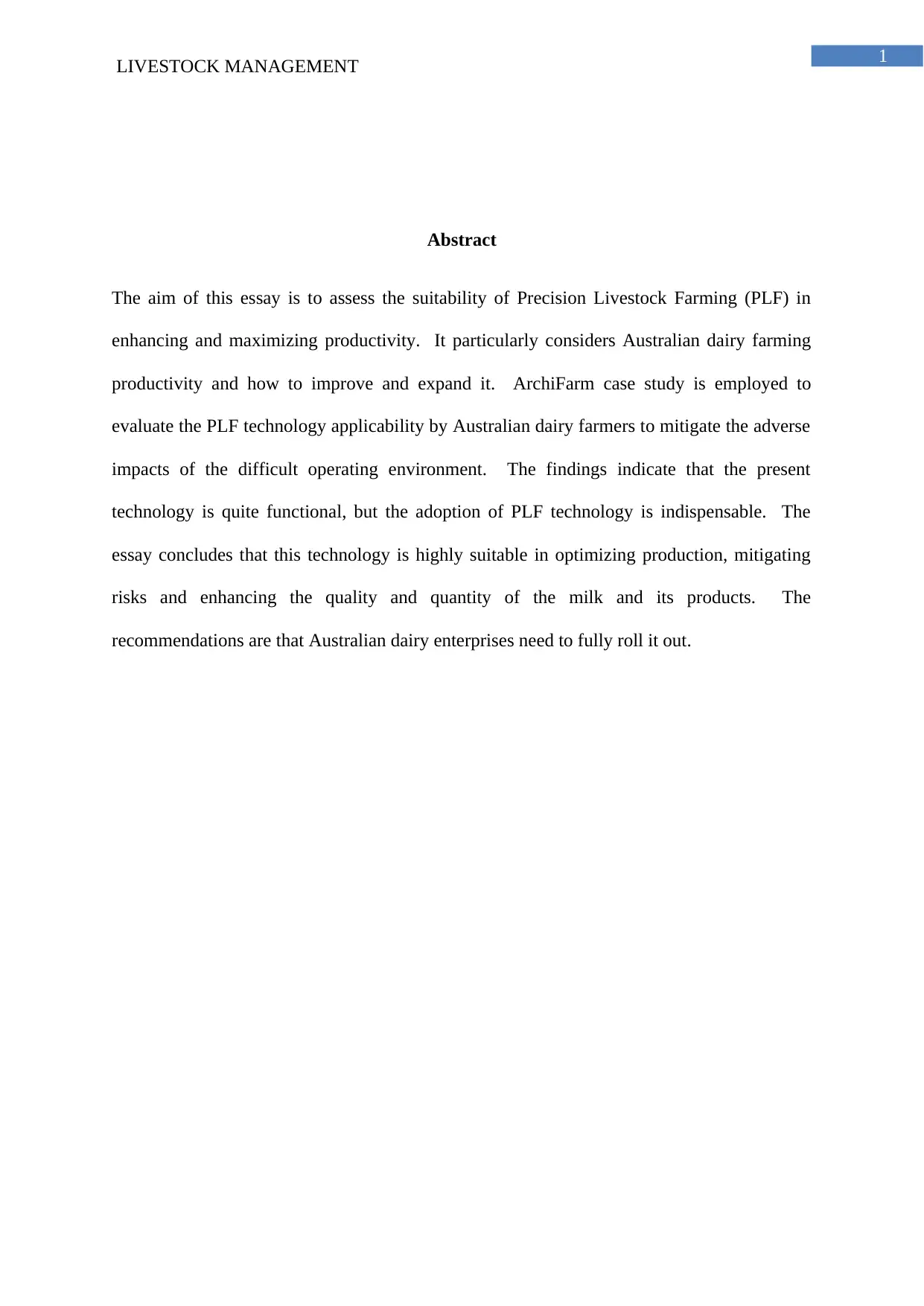
1
LIVESTOCK MANAGEMENT
Abstract
The aim of this essay is to assess the suitability of Precision Livestock Farming (PLF) in
enhancing and maximizing productivity. It particularly considers Australian dairy farming
productivity and how to improve and expand it. ArchiFarm case study is employed to
evaluate the PLF technology applicability by Australian dairy farmers to mitigate the adverse
impacts of the difficult operating environment. The findings indicate that the present
technology is quite functional, but the adoption of PLF technology is indispensable. The
essay concludes that this technology is highly suitable in optimizing production, mitigating
risks and enhancing the quality and quantity of the milk and its products. The
recommendations are that Australian dairy enterprises need to fully roll it out.
LIVESTOCK MANAGEMENT
Abstract
The aim of this essay is to assess the suitability of Precision Livestock Farming (PLF) in
enhancing and maximizing productivity. It particularly considers Australian dairy farming
productivity and how to improve and expand it. ArchiFarm case study is employed to
evaluate the PLF technology applicability by Australian dairy farmers to mitigate the adverse
impacts of the difficult operating environment. The findings indicate that the present
technology is quite functional, but the adoption of PLF technology is indispensable. The
essay concludes that this technology is highly suitable in optimizing production, mitigating
risks and enhancing the quality and quantity of the milk and its products. The
recommendations are that Australian dairy enterprises need to fully roll it out.
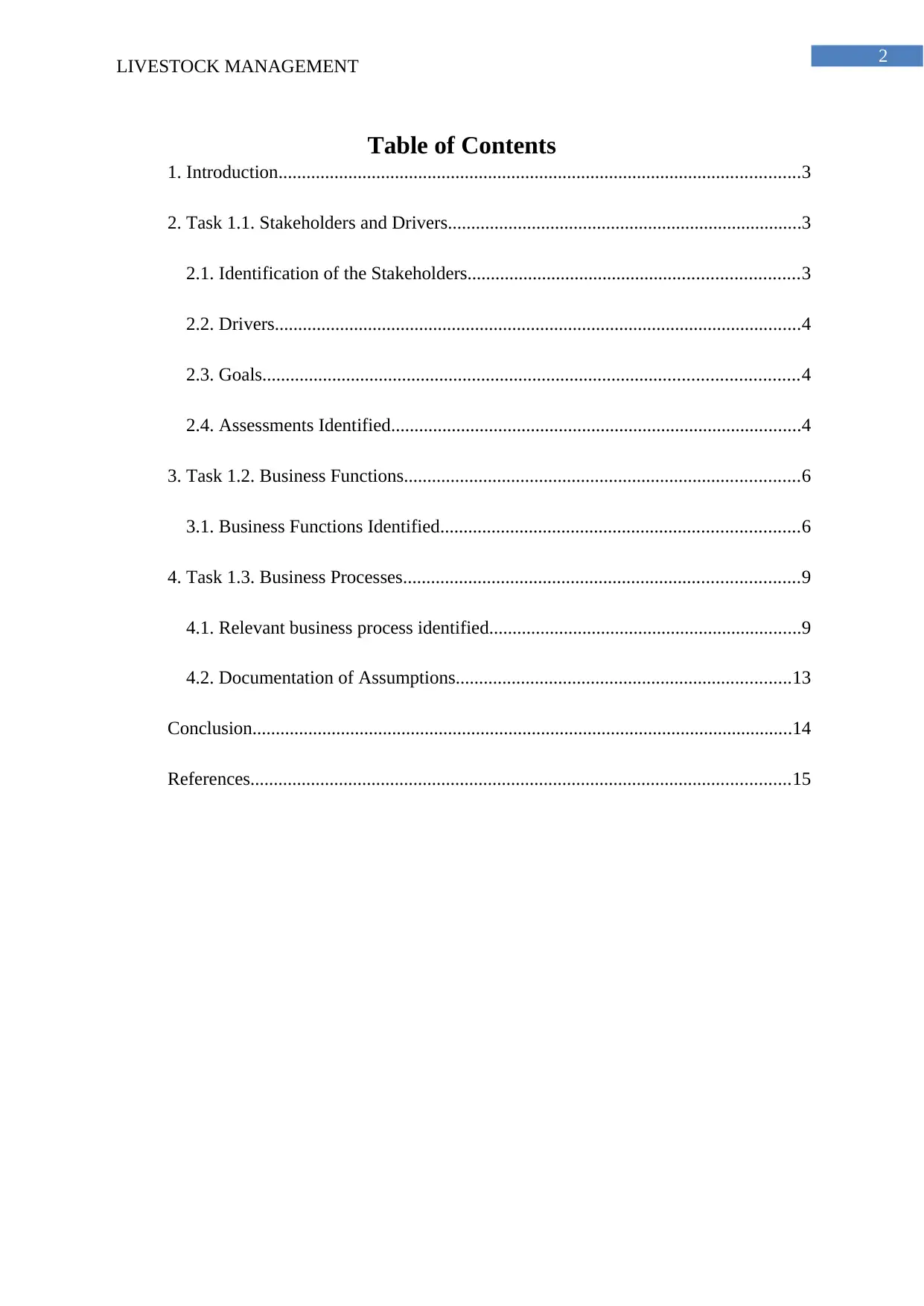
2
LIVESTOCK MANAGEMENT
Table of Contents
1. Introduction................................................................................................................3
2. Task 1.1. Stakeholders and Drivers............................................................................3
2.1. Identification of the Stakeholders.......................................................................3
2.2. Drivers.................................................................................................................4
2.3. Goals...................................................................................................................4
2.4. Assessments Identified........................................................................................4
3. Task 1.2. Business Functions.....................................................................................6
3.1. Business Functions Identified.............................................................................6
4. Task 1.3. Business Processes.....................................................................................9
4.1. Relevant business process identified...................................................................9
4.2. Documentation of Assumptions........................................................................13
Conclusion....................................................................................................................14
References....................................................................................................................15
LIVESTOCK MANAGEMENT
Table of Contents
1. Introduction................................................................................................................3
2. Task 1.1. Stakeholders and Drivers............................................................................3
2.1. Identification of the Stakeholders.......................................................................3
2.2. Drivers.................................................................................................................4
2.3. Goals...................................................................................................................4
2.4. Assessments Identified........................................................................................4
3. Task 1.2. Business Functions.....................................................................................6
3.1. Business Functions Identified.............................................................................6
4. Task 1.3. Business Processes.....................................................................................9
4.1. Relevant business process identified...................................................................9
4.2. Documentation of Assumptions........................................................................13
Conclusion....................................................................................................................14
References....................................................................................................................15
⊘ This is a preview!⊘
Do you want full access?
Subscribe today to unlock all pages.

Trusted by 1+ million students worldwide
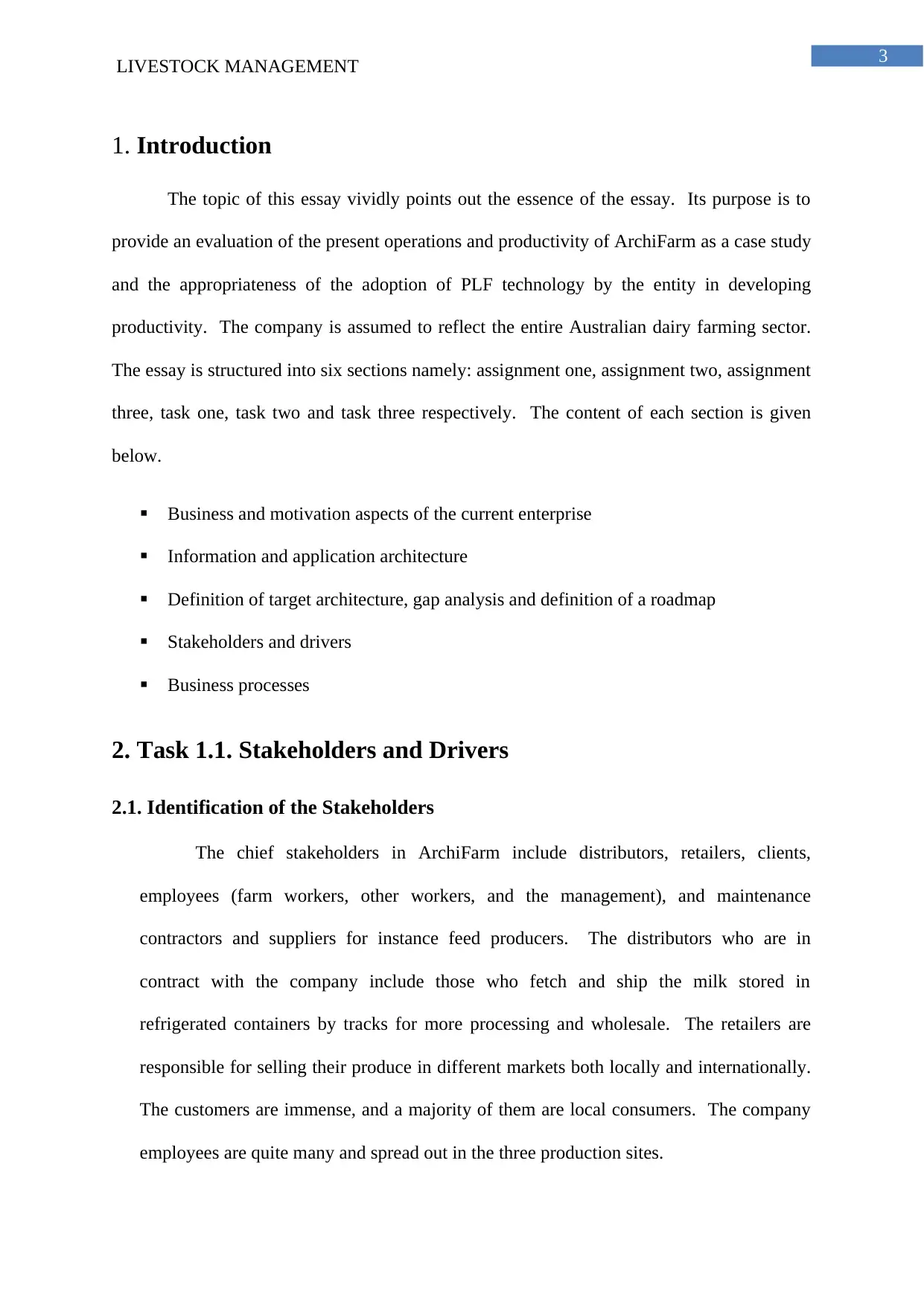
3
LIVESTOCK MANAGEMENT
1. Introduction
The topic of this essay vividly points out the essence of the essay. Its purpose is to
provide an evaluation of the present operations and productivity of ArchiFarm as a case study
and the appropriateness of the adoption of PLF technology by the entity in developing
productivity. The company is assumed to reflect the entire Australian dairy farming sector.
The essay is structured into six sections namely: assignment one, assignment two, assignment
three, task one, task two and task three respectively. The content of each section is given
below.
Business and motivation aspects of the current enterprise
Information and application architecture
Definition of target architecture, gap analysis and definition of a roadmap
Stakeholders and drivers
Business processes
2. Task 1.1. Stakeholders and Drivers
2.1. Identification of the Stakeholders
The chief stakeholders in ArchiFarm include distributors, retailers, clients,
employees (farm workers, other workers, and the management), and maintenance
contractors and suppliers for instance feed producers. The distributors who are in
contract with the company include those who fetch and ship the milk stored in
refrigerated containers by tracks for more processing and wholesale. The retailers are
responsible for selling their produce in different markets both locally and internationally.
The customers are immense, and a majority of them are local consumers. The company
employees are quite many and spread out in the three production sites.
LIVESTOCK MANAGEMENT
1. Introduction
The topic of this essay vividly points out the essence of the essay. Its purpose is to
provide an evaluation of the present operations and productivity of ArchiFarm as a case study
and the appropriateness of the adoption of PLF technology by the entity in developing
productivity. The company is assumed to reflect the entire Australian dairy farming sector.
The essay is structured into six sections namely: assignment one, assignment two, assignment
three, task one, task two and task three respectively. The content of each section is given
below.
Business and motivation aspects of the current enterprise
Information and application architecture
Definition of target architecture, gap analysis and definition of a roadmap
Stakeholders and drivers
Business processes
2. Task 1.1. Stakeholders and Drivers
2.1. Identification of the Stakeholders
The chief stakeholders in ArchiFarm include distributors, retailers, clients,
employees (farm workers, other workers, and the management), and maintenance
contractors and suppliers for instance feed producers. The distributors who are in
contract with the company include those who fetch and ship the milk stored in
refrigerated containers by tracks for more processing and wholesale. The retailers are
responsible for selling their produce in different markets both locally and internationally.
The customers are immense, and a majority of them are local consumers. The company
employees are quite many and spread out in the three production sites.
Paraphrase This Document
Need a fresh take? Get an instant paraphrase of this document with our AI Paraphraser
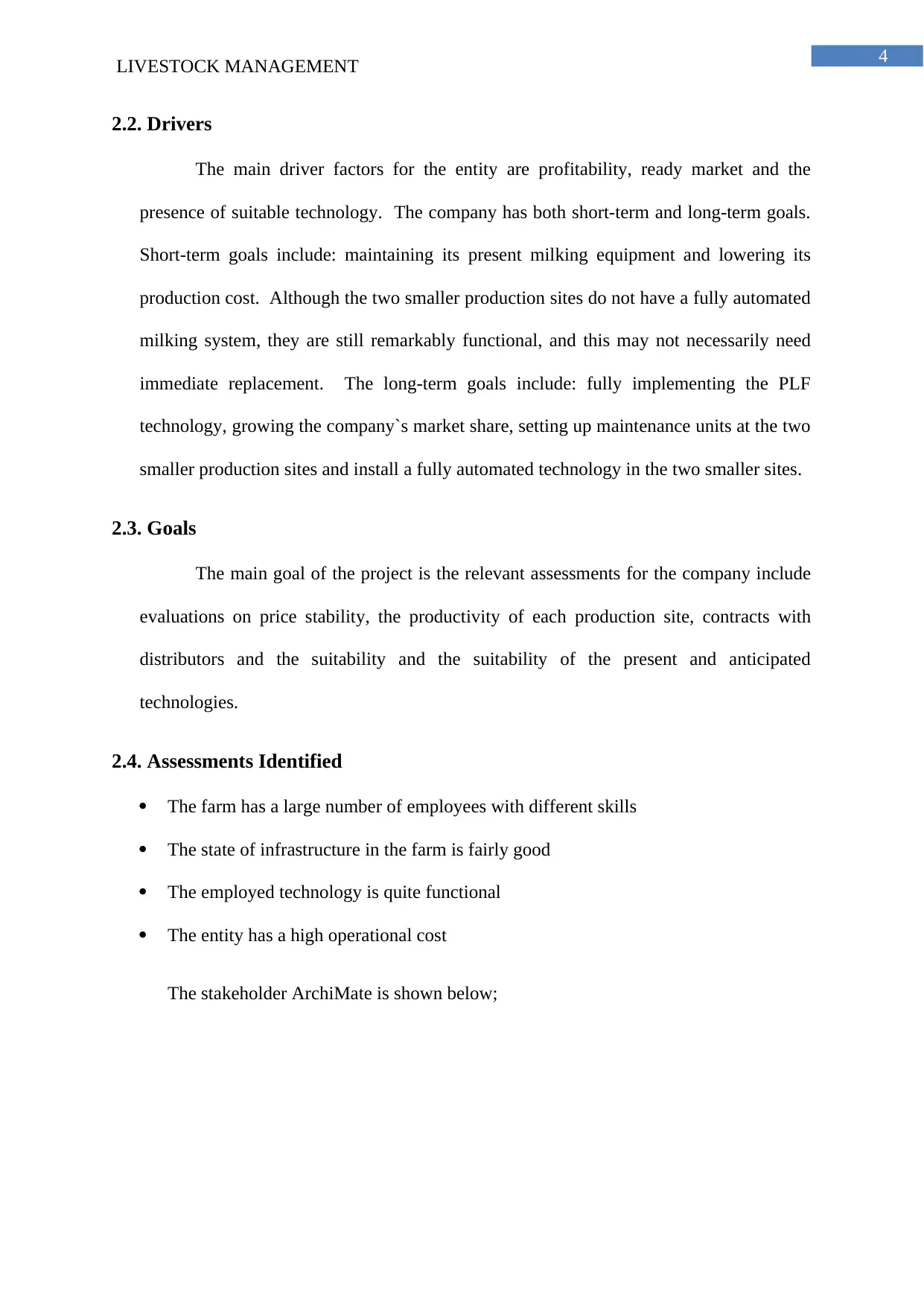
4
LIVESTOCK MANAGEMENT
2.2. Drivers
The main driver factors for the entity are profitability, ready market and the
presence of suitable technology. The company has both short-term and long-term goals.
Short-term goals include: maintaining its present milking equipment and lowering its
production cost. Although the two smaller production sites do not have a fully automated
milking system, they are still remarkably functional, and this may not necessarily need
immediate replacement. The long-term goals include: fully implementing the PLF
technology, growing the company`s market share, setting up maintenance units at the two
smaller production sites and install a fully automated technology in the two smaller sites.
2.3. Goals
The main goal of the project is the relevant assessments for the company include
evaluations on price stability, the productivity of each production site, contracts with
distributors and the suitability and the suitability of the present and anticipated
technologies.
2.4. Assessments Identified
The farm has a large number of employees with different skills
The state of infrastructure in the farm is fairly good
The employed technology is quite functional
The entity has a high operational cost
The stakeholder ArchiMate is shown below;
LIVESTOCK MANAGEMENT
2.2. Drivers
The main driver factors for the entity are profitability, ready market and the
presence of suitable technology. The company has both short-term and long-term goals.
Short-term goals include: maintaining its present milking equipment and lowering its
production cost. Although the two smaller production sites do not have a fully automated
milking system, they are still remarkably functional, and this may not necessarily need
immediate replacement. The long-term goals include: fully implementing the PLF
technology, growing the company`s market share, setting up maintenance units at the two
smaller production sites and install a fully automated technology in the two smaller sites.
2.3. Goals
The main goal of the project is the relevant assessments for the company include
evaluations on price stability, the productivity of each production site, contracts with
distributors and the suitability and the suitability of the present and anticipated
technologies.
2.4. Assessments Identified
The farm has a large number of employees with different skills
The state of infrastructure in the farm is fairly good
The employed technology is quite functional
The entity has a high operational cost
The stakeholder ArchiMate is shown below;
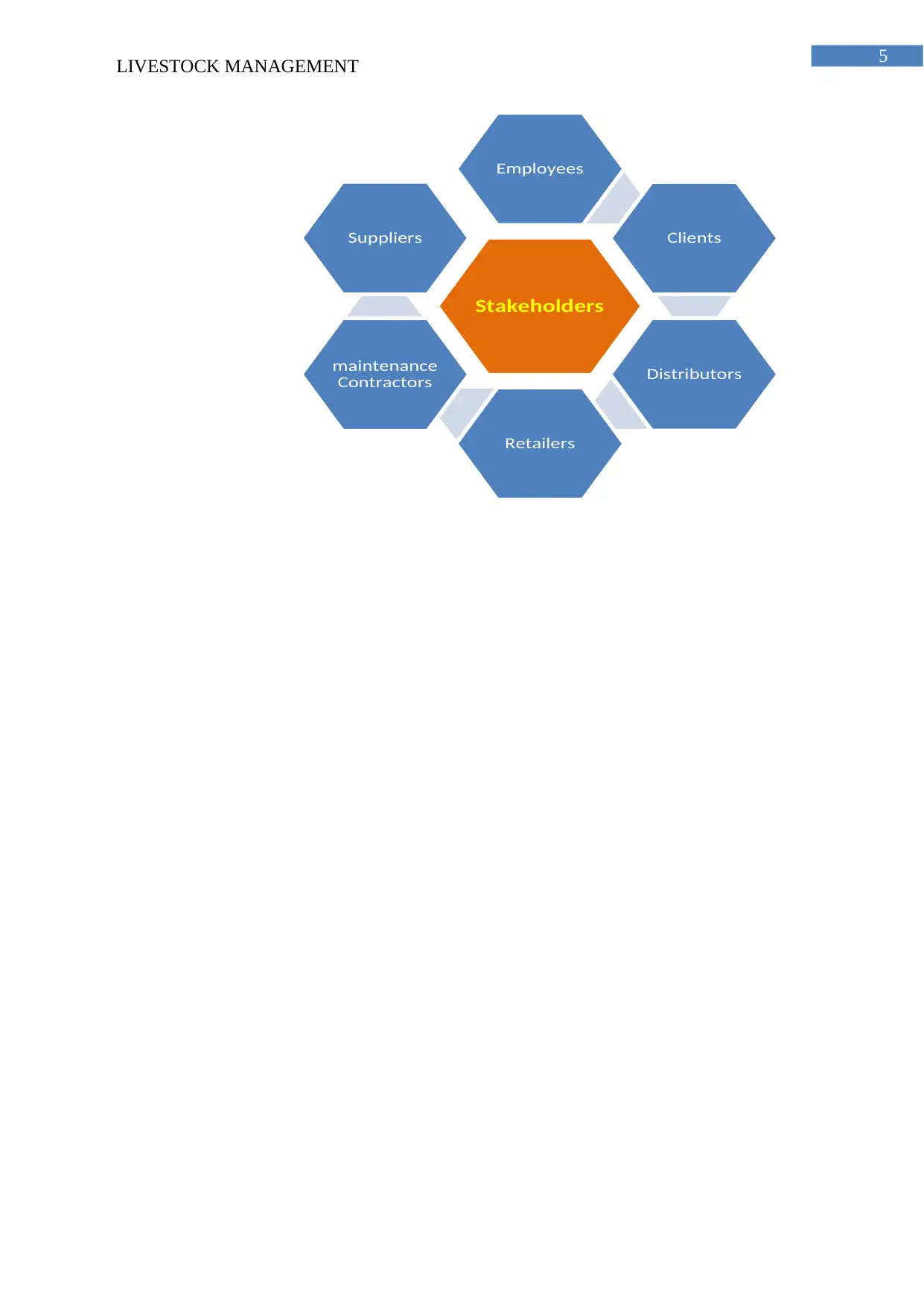
5
LIVESTOCK MANAGEMENT
Stakeholders
Employees
Clients
Distributors
Retailers
maintenance
Contractors
Suppliers
LIVESTOCK MANAGEMENT
Stakeholders
Employees
Clients
Distributors
Retailers
maintenance
Contractors
Suppliers
⊘ This is a preview!⊘
Do you want full access?
Subscribe today to unlock all pages.

Trusted by 1+ million students worldwide
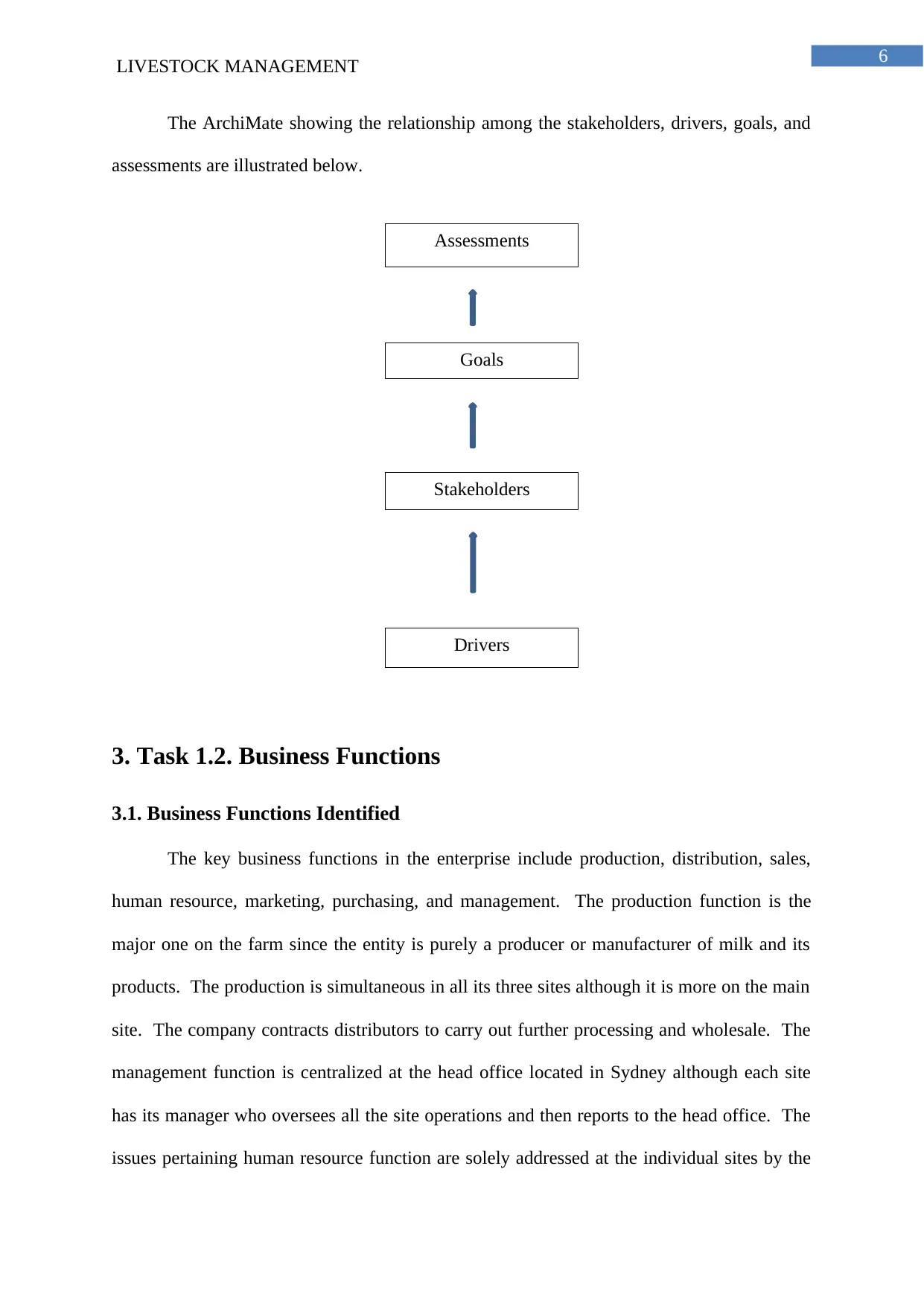
6
LIVESTOCK MANAGEMENT
The ArchiMate showing the relationship among the stakeholders, drivers, goals, and
assessments are illustrated below.
3. Task 1.2. Business Functions
3.1. Business Functions Identified
The key business functions in the enterprise include production, distribution, sales,
human resource, marketing, purchasing, and management. The production function is the
major one on the farm since the entity is purely a producer or manufacturer of milk and its
products. The production is simultaneous in all its three sites although it is more on the main
site. The company contracts distributors to carry out further processing and wholesale. The
management function is centralized at the head office located in Sydney although each site
has its manager who oversees all the site operations and then reports to the head office. The
issues pertaining human resource function are solely addressed at the individual sites by the
Assessments
Goals
Stakeholders
Drivers
LIVESTOCK MANAGEMENT
The ArchiMate showing the relationship among the stakeholders, drivers, goals, and
assessments are illustrated below.
3. Task 1.2. Business Functions
3.1. Business Functions Identified
The key business functions in the enterprise include production, distribution, sales,
human resource, marketing, purchasing, and management. The production function is the
major one on the farm since the entity is purely a producer or manufacturer of milk and its
products. The production is simultaneous in all its three sites although it is more on the main
site. The company contracts distributors to carry out further processing and wholesale. The
management function is centralized at the head office located in Sydney although each site
has its manager who oversees all the site operations and then reports to the head office. The
issues pertaining human resource function are solely addressed at the individual sites by the
Assessments
Goals
Stakeholders
Drivers
Paraphrase This Document
Need a fresh take? Get an instant paraphrase of this document with our AI Paraphraser
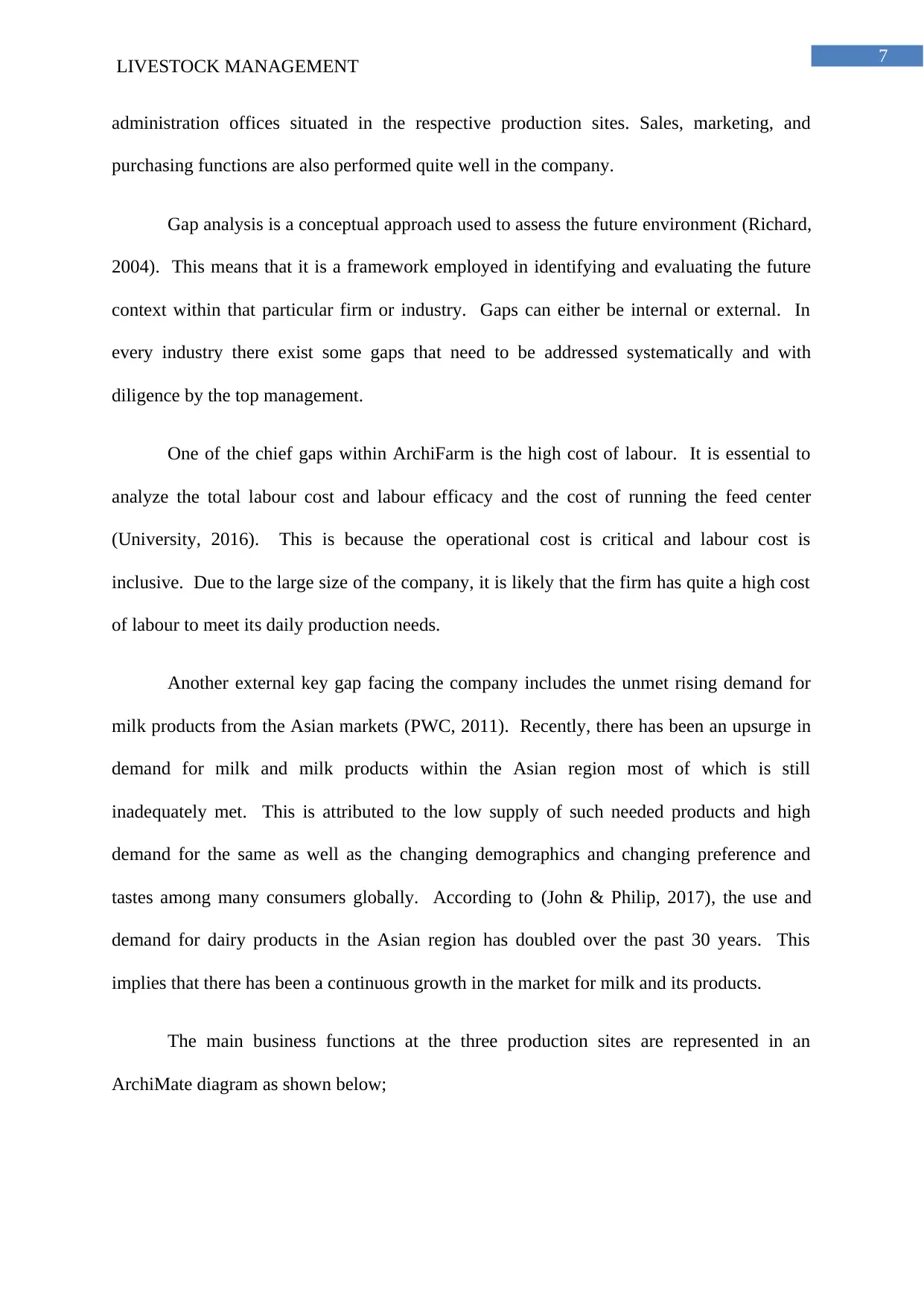
7
LIVESTOCK MANAGEMENT
administration offices situated in the respective production sites. Sales, marketing, and
purchasing functions are also performed quite well in the company.
Gap analysis is a conceptual approach used to assess the future environment (Richard,
2004). This means that it is a framework employed in identifying and evaluating the future
context within that particular firm or industry. Gaps can either be internal or external. In
every industry there exist some gaps that need to be addressed systematically and with
diligence by the top management.
One of the chief gaps within ArchiFarm is the high cost of labour. It is essential to
analyze the total labour cost and labour efficacy and the cost of running the feed center
(University, 2016). This is because the operational cost is critical and labour cost is
inclusive. Due to the large size of the company, it is likely that the firm has quite a high cost
of labour to meet its daily production needs.
Another external key gap facing the company includes the unmet rising demand for
milk products from the Asian markets (PWC, 2011). Recently, there has been an upsurge in
demand for milk and milk products within the Asian region most of which is still
inadequately met. This is attributed to the low supply of such needed products and high
demand for the same as well as the changing demographics and changing preference and
tastes among many consumers globally. According to (John & Philip, 2017), the use and
demand for dairy products in the Asian region has doubled over the past 30 years. This
implies that there has been a continuous growth in the market for milk and its products.
The main business functions at the three production sites are represented in an
ArchiMate diagram as shown below;
LIVESTOCK MANAGEMENT
administration offices situated in the respective production sites. Sales, marketing, and
purchasing functions are also performed quite well in the company.
Gap analysis is a conceptual approach used to assess the future environment (Richard,
2004). This means that it is a framework employed in identifying and evaluating the future
context within that particular firm or industry. Gaps can either be internal or external. In
every industry there exist some gaps that need to be addressed systematically and with
diligence by the top management.
One of the chief gaps within ArchiFarm is the high cost of labour. It is essential to
analyze the total labour cost and labour efficacy and the cost of running the feed center
(University, 2016). This is because the operational cost is critical and labour cost is
inclusive. Due to the large size of the company, it is likely that the firm has quite a high cost
of labour to meet its daily production needs.
Another external key gap facing the company includes the unmet rising demand for
milk products from the Asian markets (PWC, 2011). Recently, there has been an upsurge in
demand for milk and milk products within the Asian region most of which is still
inadequately met. This is attributed to the low supply of such needed products and high
demand for the same as well as the changing demographics and changing preference and
tastes among many consumers globally. According to (John & Philip, 2017), the use and
demand for dairy products in the Asian region has doubled over the past 30 years. This
implies that there has been a continuous growth in the market for milk and its products.
The main business functions at the three production sites are represented in an
ArchiMate diagram as shown below;
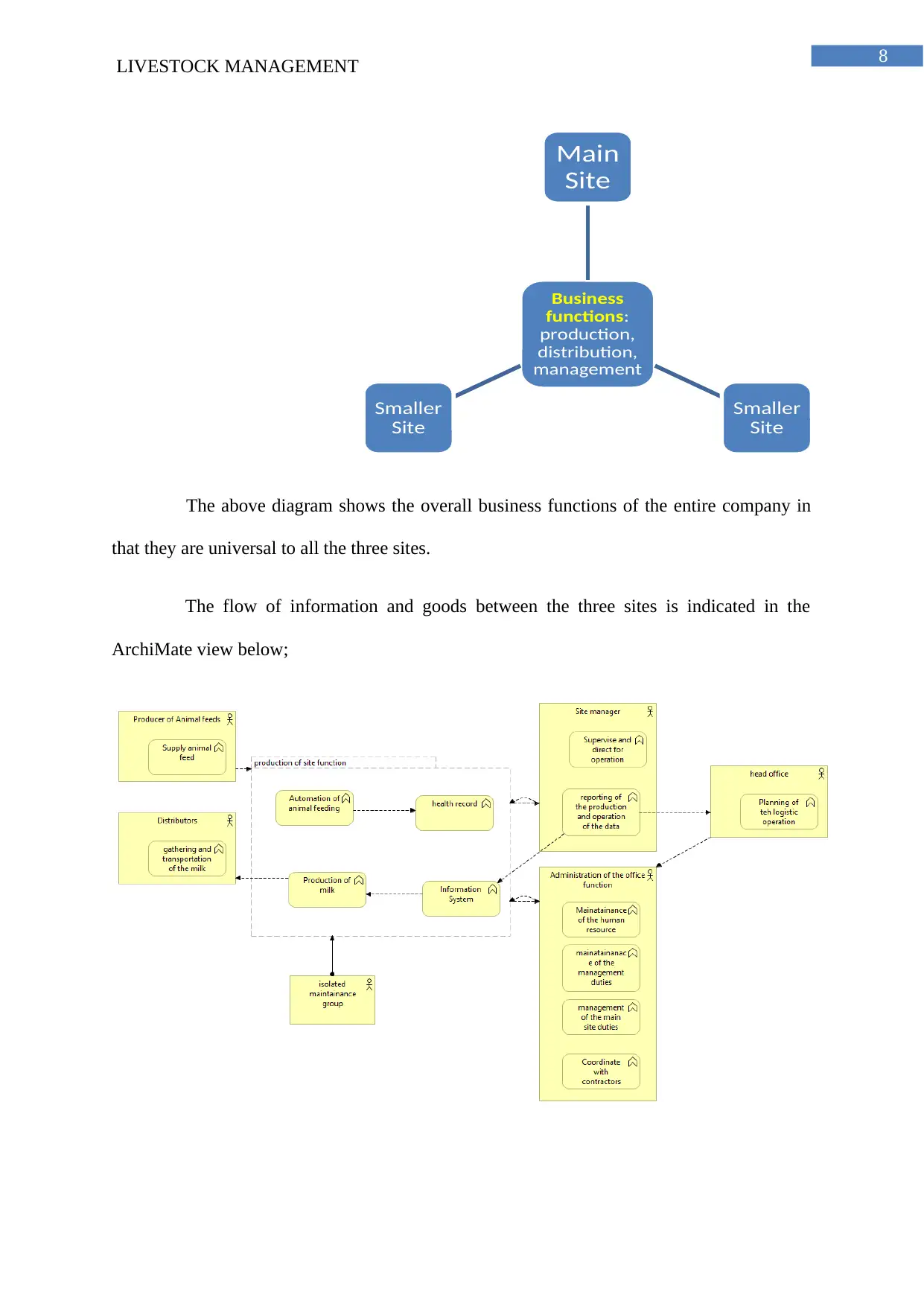
8
LIVESTOCK MANAGEMENT
The above diagram shows the overall business functions of the entire company in
that they are universal to all the three sites.
The flow of information and goods between the three sites is indicated in the
ArchiMate view below;
Business
functions:
production,
distribution,
management
Main
Site
Smaller
Site
Smaller
Site
LIVESTOCK MANAGEMENT
The above diagram shows the overall business functions of the entire company in
that they are universal to all the three sites.
The flow of information and goods between the three sites is indicated in the
ArchiMate view below;
Business
functions:
production,
distribution,
management
Main
Site
Smaller
Site
Smaller
Site
⊘ This is a preview!⊘
Do you want full access?
Subscribe today to unlock all pages.

Trusted by 1+ million students worldwide
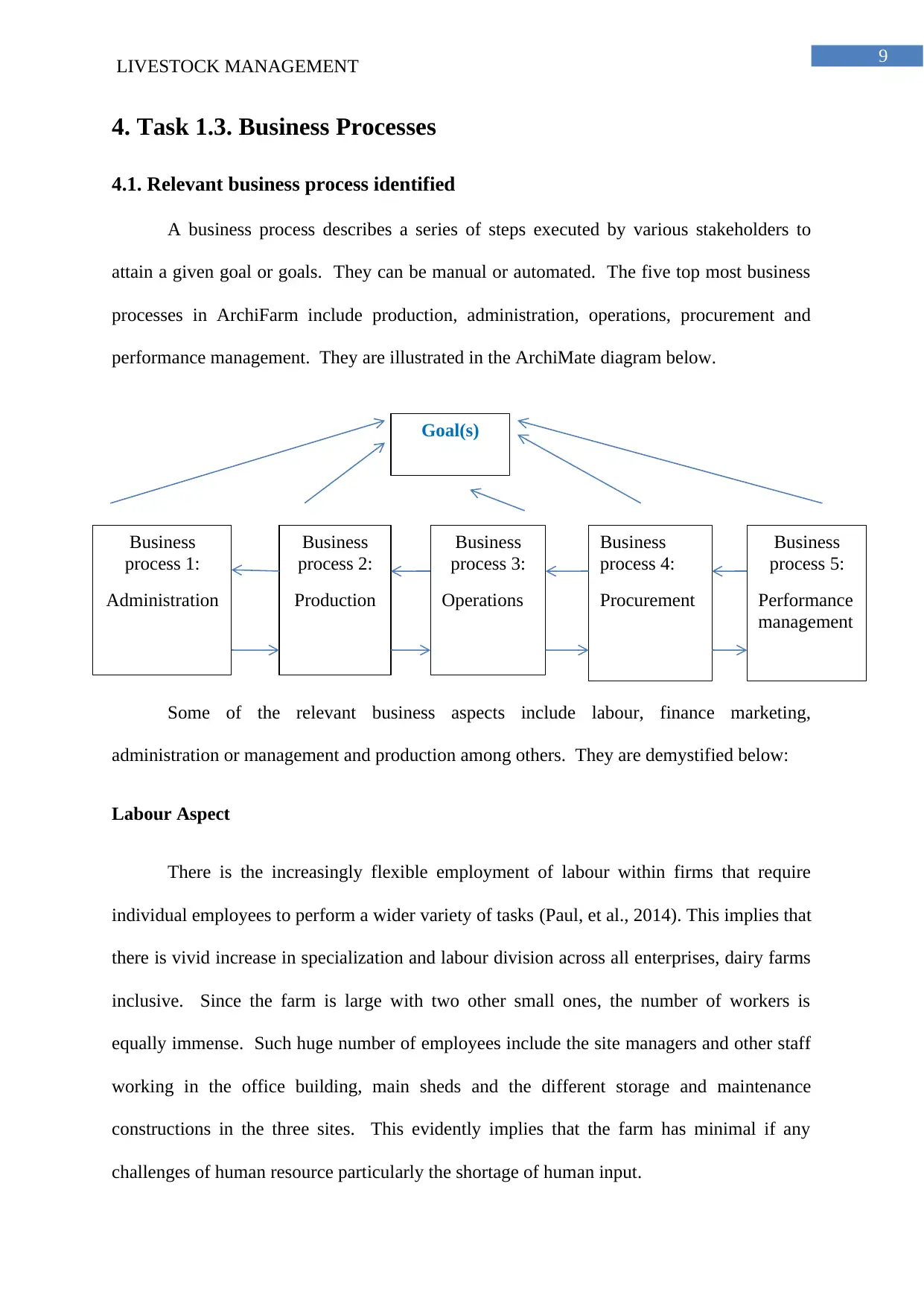
9
LIVESTOCK MANAGEMENT
4. Task 1.3. Business Processes
4.1. Relevant business process identified
A business process describes a series of steps executed by various stakeholders to
attain a given goal or goals. They can be manual or automated. The five top most business
processes in ArchiFarm include production, administration, operations, procurement and
performance management. They are illustrated in the ArchiMate diagram below.
Some of the relevant business aspects include labour, finance marketing,
administration or management and production among others. They are demystified below:
Labour Aspect
There is the increasingly flexible employment of labour within firms that require
individual employees to perform a wider variety of tasks (Paul, et al., 2014). This implies that
there is vivid increase in specialization and labour division across all enterprises, dairy farms
inclusive. Since the farm is large with two other small ones, the number of workers is
equally immense. Such huge number of employees include the site managers and other staff
working in the office building, main sheds and the different storage and maintenance
constructions in the three sites. This evidently implies that the farm has minimal if any
challenges of human resource particularly the shortage of human input.
Goal(s)
Business
process 1:
Administration
Business
process 2:
Production
Business
process 3:
Operations
Business
process 4:
Procurement
Business
process 5:
Performance
management
LIVESTOCK MANAGEMENT
4. Task 1.3. Business Processes
4.1. Relevant business process identified
A business process describes a series of steps executed by various stakeholders to
attain a given goal or goals. They can be manual or automated. The five top most business
processes in ArchiFarm include production, administration, operations, procurement and
performance management. They are illustrated in the ArchiMate diagram below.
Some of the relevant business aspects include labour, finance marketing,
administration or management and production among others. They are demystified below:
Labour Aspect
There is the increasingly flexible employment of labour within firms that require
individual employees to perform a wider variety of tasks (Paul, et al., 2014). This implies that
there is vivid increase in specialization and labour division across all enterprises, dairy farms
inclusive. Since the farm is large with two other small ones, the number of workers is
equally immense. Such huge number of employees include the site managers and other staff
working in the office building, main sheds and the different storage and maintenance
constructions in the three sites. This evidently implies that the farm has minimal if any
challenges of human resource particularly the shortage of human input.
Goal(s)
Business
process 1:
Administration
Business
process 2:
Production
Business
process 3:
Operations
Business
process 4:
Procurement
Business
process 5:
Performance
management
Paraphrase This Document
Need a fresh take? Get an instant paraphrase of this document with our AI Paraphraser
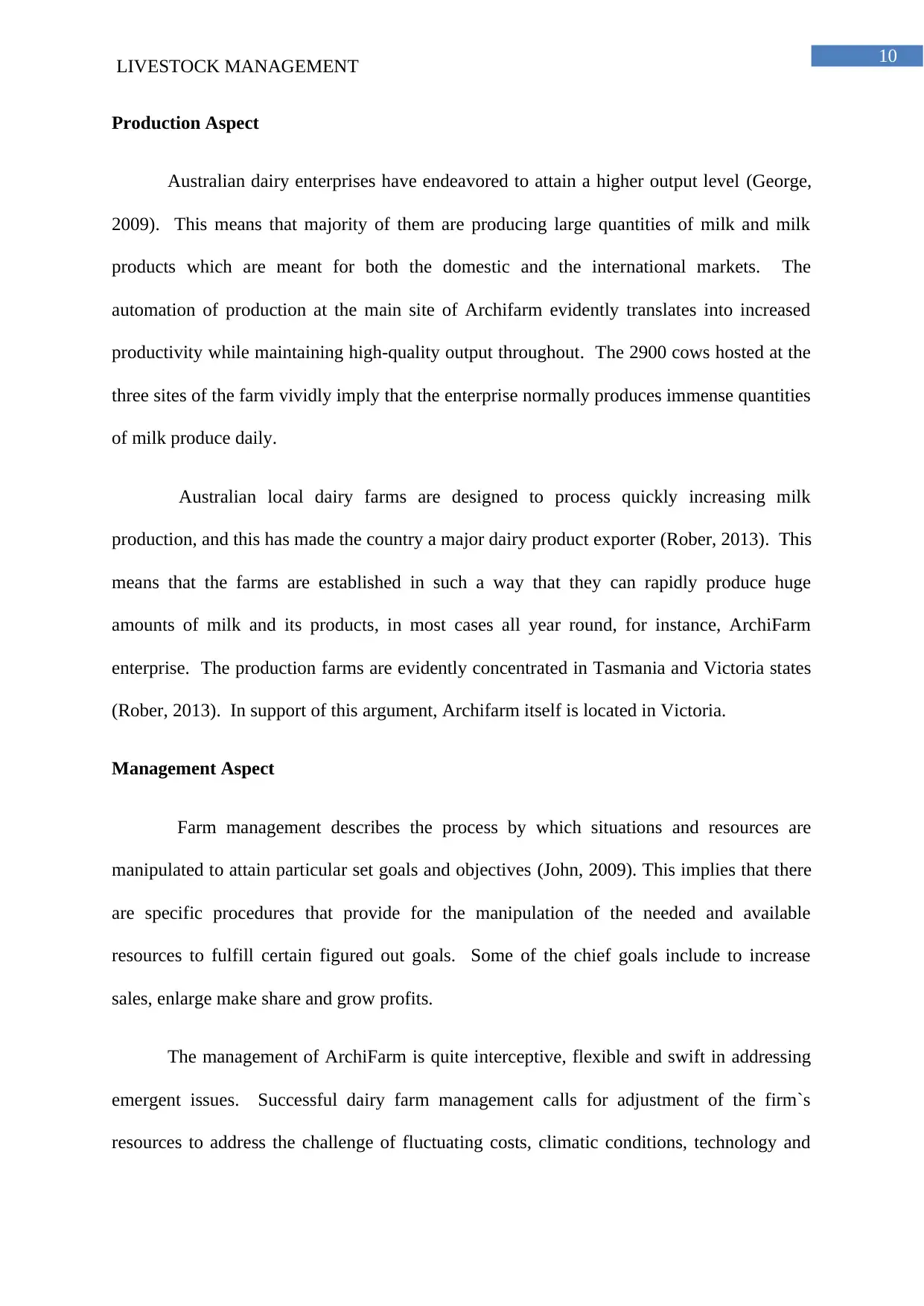
10
LIVESTOCK MANAGEMENT
Production Aspect
Australian dairy enterprises have endeavored to attain a higher output level (George,
2009). This means that majority of them are producing large quantities of milk and milk
products which are meant for both the domestic and the international markets. The
automation of production at the main site of Archifarm evidently translates into increased
productivity while maintaining high-quality output throughout. The 2900 cows hosted at the
three sites of the farm vividly imply that the enterprise normally produces immense quantities
of milk produce daily.
Australian local dairy farms are designed to process quickly increasing milk
production, and this has made the country a major dairy product exporter (Rober, 2013). This
means that the farms are established in such a way that they can rapidly produce huge
amounts of milk and its products, in most cases all year round, for instance, ArchiFarm
enterprise. The production farms are evidently concentrated in Tasmania and Victoria states
(Rober, 2013). In support of this argument, Archifarm itself is located in Victoria.
Management Aspect
Farm management describes the process by which situations and resources are
manipulated to attain particular set goals and objectives (John, 2009). This implies that there
are specific procedures that provide for the manipulation of the needed and available
resources to fulfill certain figured out goals. Some of the chief goals include to increase
sales, enlarge make share and grow profits.
The management of ArchiFarm is quite interceptive, flexible and swift in addressing
emergent issues. Successful dairy farm management calls for adjustment of the firm`s
resources to address the challenge of fluctuating costs, climatic conditions, technology and
LIVESTOCK MANAGEMENT
Production Aspect
Australian dairy enterprises have endeavored to attain a higher output level (George,
2009). This means that majority of them are producing large quantities of milk and milk
products which are meant for both the domestic and the international markets. The
automation of production at the main site of Archifarm evidently translates into increased
productivity while maintaining high-quality output throughout. The 2900 cows hosted at the
three sites of the farm vividly imply that the enterprise normally produces immense quantities
of milk produce daily.
Australian local dairy farms are designed to process quickly increasing milk
production, and this has made the country a major dairy product exporter (Rober, 2013). This
means that the farms are established in such a way that they can rapidly produce huge
amounts of milk and its products, in most cases all year round, for instance, ArchiFarm
enterprise. The production farms are evidently concentrated in Tasmania and Victoria states
(Rober, 2013). In support of this argument, Archifarm itself is located in Victoria.
Management Aspect
Farm management describes the process by which situations and resources are
manipulated to attain particular set goals and objectives (John, 2009). This implies that there
are specific procedures that provide for the manipulation of the needed and available
resources to fulfill certain figured out goals. Some of the chief goals include to increase
sales, enlarge make share and grow profits.
The management of ArchiFarm is quite interceptive, flexible and swift in addressing
emergent issues. Successful dairy farm management calls for adjustment of the firm`s
resources to address the challenge of fluctuating costs, climatic conditions, technology and
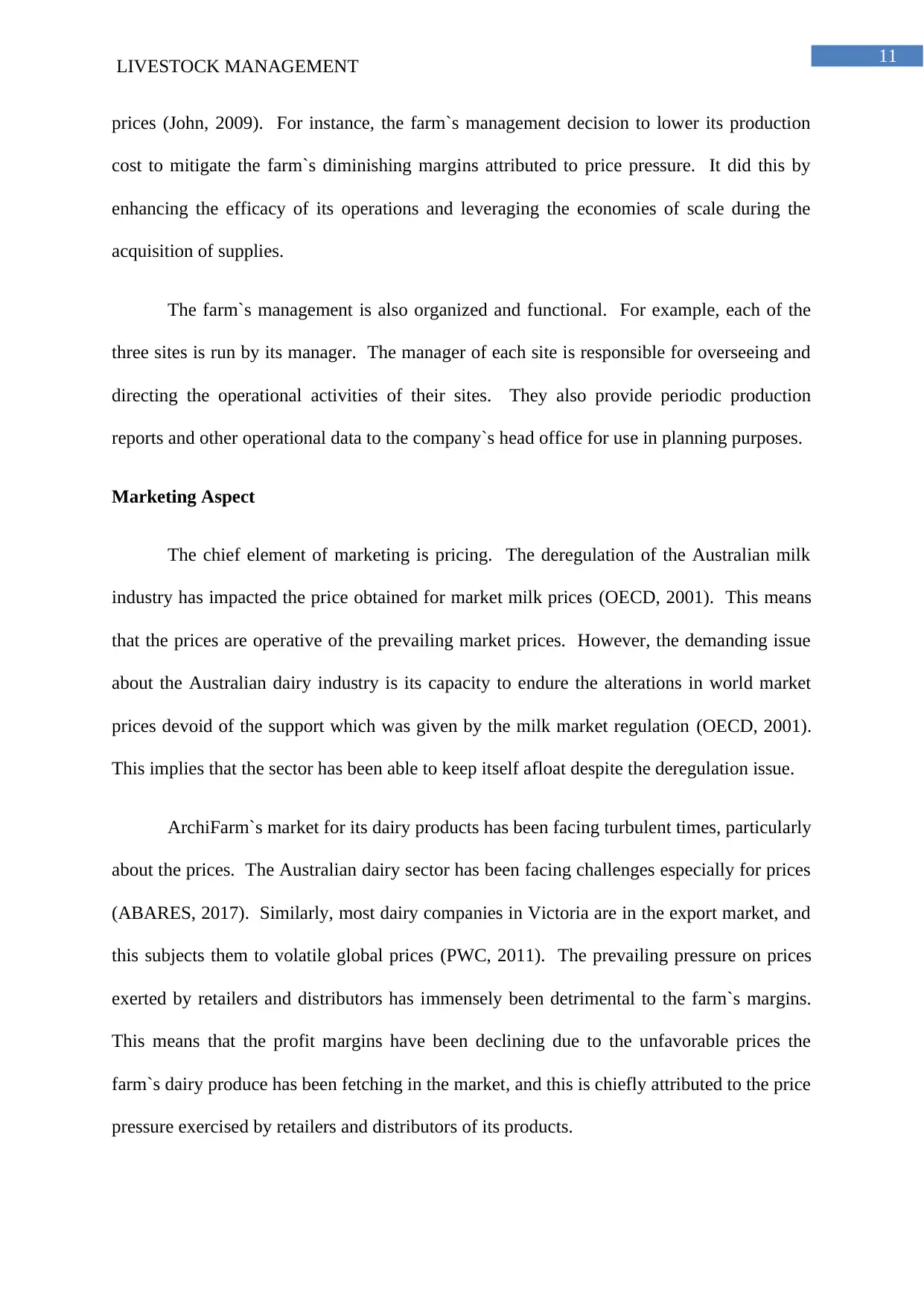
11
LIVESTOCK MANAGEMENT
prices (John, 2009). For instance, the farm`s management decision to lower its production
cost to mitigate the farm`s diminishing margins attributed to price pressure. It did this by
enhancing the efficacy of its operations and leveraging the economies of scale during the
acquisition of supplies.
The farm`s management is also organized and functional. For example, each of the
three sites is run by its manager. The manager of each site is responsible for overseeing and
directing the operational activities of their sites. They also provide periodic production
reports and other operational data to the company`s head office for use in planning purposes.
Marketing Aspect
The chief element of marketing is pricing. The deregulation of the Australian milk
industry has impacted the price obtained for market milk prices (OECD, 2001). This means
that the prices are operative of the prevailing market prices. However, the demanding issue
about the Australian dairy industry is its capacity to endure the alterations in world market
prices devoid of the support which was given by the milk market regulation (OECD, 2001).
This implies that the sector has been able to keep itself afloat despite the deregulation issue.
ArchiFarm`s market for its dairy products has been facing turbulent times, particularly
about the prices. The Australian dairy sector has been facing challenges especially for prices
(ABARES, 2017). Similarly, most dairy companies in Victoria are in the export market, and
this subjects them to volatile global prices (PWC, 2011). The prevailing pressure on prices
exerted by retailers and distributors has immensely been detrimental to the farm`s margins.
This means that the profit margins have been declining due to the unfavorable prices the
farm`s dairy produce has been fetching in the market, and this is chiefly attributed to the price
pressure exercised by retailers and distributors of its products.
LIVESTOCK MANAGEMENT
prices (John, 2009). For instance, the farm`s management decision to lower its production
cost to mitigate the farm`s diminishing margins attributed to price pressure. It did this by
enhancing the efficacy of its operations and leveraging the economies of scale during the
acquisition of supplies.
The farm`s management is also organized and functional. For example, each of the
three sites is run by its manager. The manager of each site is responsible for overseeing and
directing the operational activities of their sites. They also provide periodic production
reports and other operational data to the company`s head office for use in planning purposes.
Marketing Aspect
The chief element of marketing is pricing. The deregulation of the Australian milk
industry has impacted the price obtained for market milk prices (OECD, 2001). This means
that the prices are operative of the prevailing market prices. However, the demanding issue
about the Australian dairy industry is its capacity to endure the alterations in world market
prices devoid of the support which was given by the milk market regulation (OECD, 2001).
This implies that the sector has been able to keep itself afloat despite the deregulation issue.
ArchiFarm`s market for its dairy products has been facing turbulent times, particularly
about the prices. The Australian dairy sector has been facing challenges especially for prices
(ABARES, 2017). Similarly, most dairy companies in Victoria are in the export market, and
this subjects them to volatile global prices (PWC, 2011). The prevailing pressure on prices
exerted by retailers and distributors has immensely been detrimental to the farm`s margins.
This means that the profit margins have been declining due to the unfavorable prices the
farm`s dairy produce has been fetching in the market, and this is chiefly attributed to the price
pressure exercised by retailers and distributors of its products.
⊘ This is a preview!⊘
Do you want full access?
Subscribe today to unlock all pages.

Trusted by 1+ million students worldwide
1 out of 18
Related Documents
Your All-in-One AI-Powered Toolkit for Academic Success.
+13062052269
info@desklib.com
Available 24*7 on WhatsApp / Email
![[object Object]](/_next/static/media/star-bottom.7253800d.svg)
Unlock your academic potential
Copyright © 2020–2025 A2Z Services. All Rights Reserved. Developed and managed by ZUCOL.





